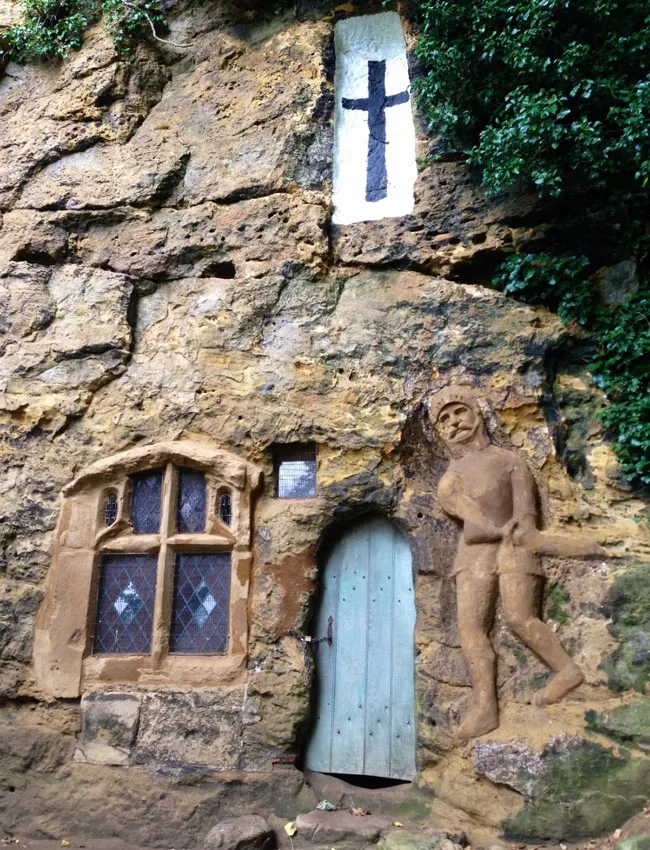
Introduction
The Chapel of Our Lady of the Crag (sometimes known as The Chapel in the Rock) is an early 15th-century chapel carved into the solid limestone of a cliff face a stone’s throw from the River Nidd in the historic Yorkshire town of Knaresborough.
The early-fifteenth century Chapel of Our Lady of the Crag is located in an old quarry on Abbey Road beside the Nidd Gorge at Knaresborough and is an early 15th century chapel cut out of the sandstone of the river gorge cliff face. It is a Marian shrine on the old pilgrim’s route to the now demolished Knaresborough Priory and close to the ancient stone quarry that was used for building works at Knaresborough Castle, the parish church and elsewhere. It was also once known as Quarry Chapel or Our Lady of the Quarry.
The Chapel of Our Lady of the Crag is not simply a remarkable historic site; it is a consecrated place of worship. It is a Marian shrine, dedicated to the Virgin Mary and Jesus Christ and is owned by Ample forth Abbey.
The Chapel of Our Lady of the Crag is a ‘Marian’ shrine dedicated to the Virgin Mary and her son, Jesus Christ. The Chapel was built by someone known as ‘John the Mason’ in 1408. A Royal Charter attests to the date, but the rest of the founding story is either legend or conjecture! John the Mason probably worked to obtain stone for Knaresborough Castle from the nearby quarry. The story goes that his son was almost killed by a rock fall in the quarry. John fervently prayed to the Virgin Mary to save him. When he emerged, miraculously unscathed, from the rubble, John built this chapel in thanksgiving.
There are two other reasons that might have prompted him to have hewn the Chapel out of the rock. Firstly, the Chapel is a wayside shrine, and in 1408 it was en route to Knaresborough’s priory (destroyed at the Reformation). Secondly, John would have loved to have displayed his skills to the people of his day; the Chapel is the work of a master craftsman, with a carved altar, vaulted ceiling, roof bosses and gargoyles, looking every bit like an erected building, but with a special quality, created from the crag itself.
The Chapel is sometimes confused with St Robert’s Cave a mile downriver, where the 12th-century hermit Robert Flower had a chapel dedicated to the Holy Cross. William Wordsworth confuses the two chapels in his 1814 work ‘Memorials of a Tour in Scotland’.

We know very little about the chapel’s creation, but documents show that John the Mason was granted permission to build a chapel by King Henry IV in 1408. John was probably a master mason working on nearby Knaresborough Castle on behalf of the king and repairing the parish church of St Mary (now rededicated to St John the Baptist). It seems likely that John the Mason worked to quarry stone for rebuilding the castle from a nearby site.
The traditional story of the chapel foundation says that John’s son narrowly escaped death in a rock fall at the quarry. The boy was playing while his father worked when a sudden fall of rock began to tumble towards him. John the Mason was too far away to grab the boy in time, so he cried out to the Virgin Mary to save him.
Miraculously, the rock fall changed direction and missed the child, who was frightened but unharmed. In gratitude for his child’s deliverance, John applied for permission to build a chapel into the solid rock of the nearby cliff face.
In an interesting side note, twenty years after the incident in the quarry, the Archbishop of York visited St Mary’s church in Knaresborough and the priest who greeted him was John Mason. Did the boy become a priest after his miraculous deliverance from certain death?
The chapel stands on the old route to Knaresborough Priory and served as a wayside shrine for travellers going to and from the Priory as well as a place of worship for stonecutters at the quarry. There may have been a more practical reason as well; John was a master mason, the medieval equivalent of a builder, or contractor, and the chapel served as a way to showcase his skills to potential clients.
And make no mistake, though the chapel is hewn from the solid rock, it is a work of art, with exceptional carving detail despite the weathering of centuries. John carved an altar out of the rock wall, added a vaulted ceiling with intricate roof bosses and a series of carved heads.
History : 1408 - 1916
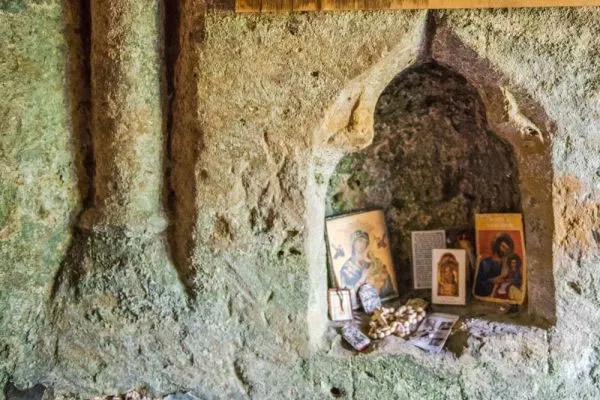
In the court rolls for 1408, the license granted to John Mason reads in translation from the Latin: ‘John Mason received from the lord a piece of waste land below the quarry with licence to excavate there beneath the quarry in order to make and hold a chapel; which he and his assigns are to have and to hold for the term of their life for an annual rent’.
The chapel was frequently referred to thereafter in later deeds in such terms as ‘Chapel of Our Ladie of the Crag’ or ‘Quarrell Chapel’ or ‘Our Lady of the Quarrell’. For example, as late as 1657 Will Conyers bequeathed ‘one field within the parish of Knaresborough commonly called the Quarry Field or the Ladie of the Quarry.’ The title ‘Our Lady of the Crag’ is the one that survived.
The founder of the chapel, John the Mason, was probably the Master builder engaged in repairing the castle and the medieval parish church of Knaresborough. This latter is now dedicated to St John the Baptist but prior to the Reformation, it was dedicated to St Mary. The modern Roman Catholic church at Bond End, established in the 19th century, has therefore reclaimed the name St Mary’s, and a statue of our Lady of the Crag now resides in the church garden.
There is a story that attributes the founding of the chapel to a divine miracle. Its historical basis is uncertain, but it has become part of the folklore of the shrine. It is told in this way: one day, John’s young son had accompanied his father to the quarry. As he played there a rock fall started without warning and John’s son was right in its path. John was too far away to snatch his son to safety, but he cried out a prayer to Mary to protect the boy.
Miraculously the rock fall changed course and the lad was unharmed. It was in thanksgiving for this that John founded the chapel. It is interesting to note that in 1428 the Archbishop of York visited Knaresborough and the priest of St Mary’s parish church at this time was – John Mason. It is nice to think that John’s son who was saved from the rock fall eventually became a priest and offered Mass in his father’s chapel!
The details of what the chapel contained in its early years are not known, nor what happened to the original statue of Madonna and Child, if there was one. It may have have suffered the same fate as the statues of our Lady of Walsingham, Doncaster, Ipswich, Willesden and Penrhys that were publicly burned during the Reformation, in the 1530s. We do not know whether the figure of the knight was carved at the same time as the chapel, although there is no reason to think otherwise.
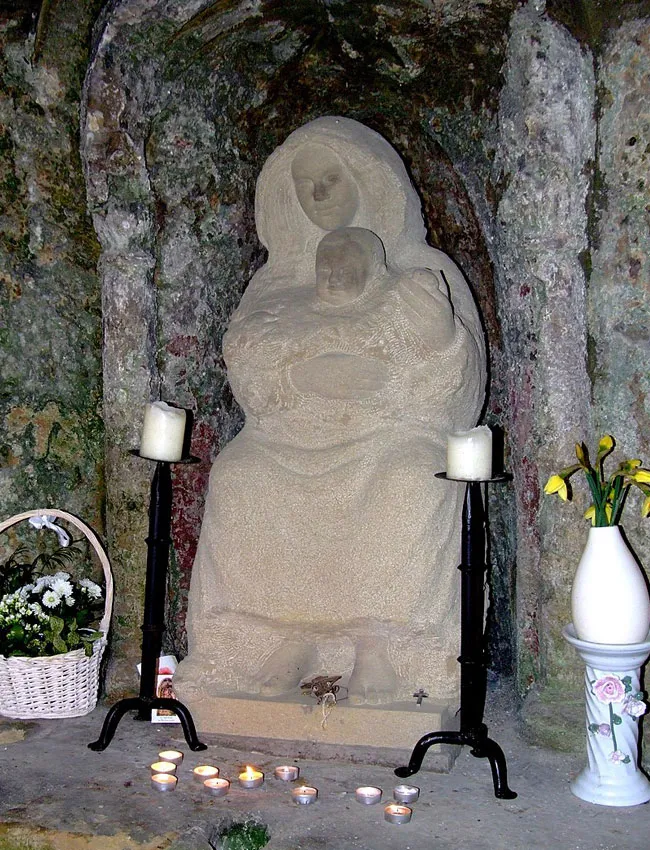
Neither do we know the origins of the carved heads inside the chapel, and exactly what they meant to their creators. We do not know when the windows were added. However, with all its mysteries it is a rare and striking building, remarkable for having been hewn from the rock with altar and vaulted ceiling.
The chapel is reasonably well-known nationally, being mentioned in several travelogues and local histories from the 16th century onwards. In 1540 soon after the suppression of the monasteries, the antiquary John Leland visited Knaresborough and recorded that he saw ‘an old chapel yn a Rock hewed oute of the mayn stone’ but no other detail is given. Well after the Reformation there are reports of the chapel being well attended.
In her diary of around 1700, Celia Fiennes reported that she visited Knaresborough ‘to see a chapel with alter decked with flowers and the ground with rushes for ye devout which did frequent it.’ So there were probably Catholic devotions still being practised in secret in Knaresborough at this time. The owner in the 1700s was a member of the Slingsby family, the son of a royalist martyr and a Catholic mother.
Not all visitors admired the shrine, however: in his Rides around Britain (1792), Viscount Torrington wrote ‘the only thing in character here is an old ivy tree covering much of the front. Within it is filthy; and without there is a little dirty flower garden’!
For some time in the 18th and 19th centuries, the Chapel of our Lady of the Crag was confused with St Robert’s Cave and his own Holy Cross Chapel, which is about a mile further down the river Nidd. This error found its way into the most famous mention of the shrine by William Wordsworth in the third section of Memorials of a Tour in Scotland 1814.
Although he wrongly suggests that St Robert lived in the Chapel of Our lady of the Crag and that his body had been interred there, only to be later removed to the Abbey, Wordsworth’s poem shows how the shrine has a particular emotional power because of its natural beauty. In the modern context, with our growing concern for the environment ancient, tranquil places like Our Lady of the Crag can become symbols of the spiritual value of Nature in itself.
An archaeological survey in the late 1990s confirms what was already known: that the Crag was the site of many rough dwellings over the centuries. The rock provides one secure back wall for the shanty residences of poor people, and the evidence for this can be seen in the many post holes that still mark the sandstone of the Crag. What use they made of the chapel we do not know but they were gone by the end of the Victorian period.
History : 1916 - 2021

In 1916, the land was bequeathed to Ample forth Abbey, and so returned to Catholic hands. The Benedictines of Ample forth have a link with Knaresborough that goes back to the 17th century. Ample forth Abbey continues to provide the parish priest to serve the Catholic parish of St Mary’s. In the early 20th century ‘restoration work’ was carried out in the chapel and three carved heads on the right-hand wall were removed to make way for the plaque.
With today’s laws protecting heritage sites this work would not have been possible. The three heads can be seen in old pictures. In 1919 a new statue of our Lady of the Crag was obtained for the Chapel, which can now be seen in the parish garden of St Mary’s Church, Bond End. In 1952, the Chapel was designated a Grade 1 listed building, as a site of special historical or architectural interest.
In the 1990s, in the context of an increasing interest in shrines and pilgrimages, several local people sought to improve the site. This led to a contact with the Sacred Land Project, a national enterprise for the restoration and the creation of religious sites, founded by the International Consultancy for Religion, Education and Culture.
This organisation was sponsored by the World Wide Fund for Nature and was launched by the Duke of Edinburgh and the Archbishop of Canterbury in 1997. The Sacred Land Project was promoted on BBC Radio 4’s Sunday worship broadcasts, the first of which was recorded here in Knaresborough.
Being part of the Sacred Land Project resulted in the shrine receiving a millennium grant from the Arts and Sacred Places organisation. The group chose to use this funding for a new statue, as the 1919 statue was not a good fit for the niche in the chapel and its decorative colouring did not resonate with the hardness of the rock. The 2000 statue was an altogether more robust image of the Madonna and Child, carved from Derbyshire grit stone by the Yorkshire sculptor Ian Judd, and weighing about half a ton. It was placed in the chapel with considerable effort and care at the direction of the sculptor!
The new statue was dedicated during a special Mass by the Abbot of Ample forth. This took place along with a display of artwork and public readings of specially-commissioned poetry, all of which was funded by the Arts and Sacred Places organisation.
2008 was an important year for the chapel, being the 600th anniversary of its foundation. The group organised events to celebrate this and to raise money for the on-going maintenance and improvement of the site. Around this time the local council agreed to place better signage to help visitors find the chapel, and a blue plaque was placed on the boundary wall.
Also in the mid-2000s, Peter and Viv Thornes planted the award-winning garden which is there today, with the upper part including plants associated with healing, the lower with plants associated with the Virgin Mary and Saints from medieval times. The path leading up to the chapel was improved and handrails provided for ease of climbing up from the road.
In July 2016, one hundred years after the chapel was endowed to the Catholic community, Ample forth Abbey decided that it could no longer fulfil the requirements and responsibilities associated with the chapel and its land. It was therefore decided that the chapel site would be sold to the existing volunteer committee, which would be constituted as an independent Charitable Incorporated Organisation, the site to be held and maintained both as a heritage site, and a shrine of the Blessed Virgin Mary.
On the 6th March 2017, the group were formally constituted as ‘The Chapel of Our Lady of the Crag Trust’, charity number 1171904. We can collect funds (including Gift Aid) which we will use for maintaining and enhancing the chapel and its grounds within the guidelines established by English Heritage.
Architecture of Our Lady of the Crag, Knaresborough
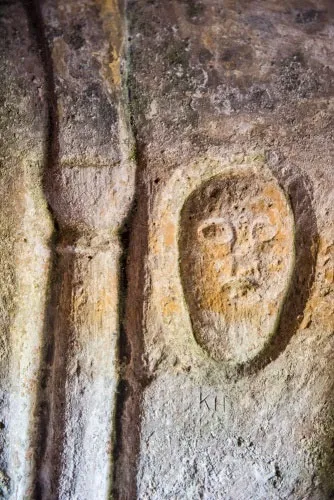
This Oratory Chapel, a place for prayer, was built possibly by a master mason, known as ‘John the Mason’ or ‘John Mason’, in 1408 or 1409. The chapel was a recorded in a charter of King Henry IV “John Mason received from the lord a piece of waste land below the quarry with licence to excavate there beneath the quarry in order to make and hold a chapel; which he and his assigns are to have and to hold for the term of their life for an annual rent.”
Various versions of the legend of its creation exist, one of which is that John the Mason was working in the nearby quarry when he saw that a rock fall was about to engulf and kill his son, unable to reach him in time he prayed to the Virgin Mary and miraculously the stones changed direction and his son was saved. John pledged to create a chapel as thanks for the miracle.
It ceased to function as a chapel following Henry VIII’s Reformation, however in 1916 it was reconsecrated as a Catholic place of worship[3] after becoming the property of Ample forth Abbey. Three carved heads located on the right-hand wall were taken away at this time. A new statue of our Lady of the Crag was provided for the Chapel.
The chapel has had several mentions by travellers over the years and was visited by pilgrims between the sixteenth and seventeenth centuries. It has often been confused with the Holy Cross Chapel and cave of St Robert of Knaresborough that lie further down the River Nidd.
The crag has been the site of many rough dwellings over the centuries, such as simple shanty dwellings as evidenced by the many post holes cut into the sandstone of the cliff. The chapel cave’s use is not recorded however by the end of the Victorian era the basic lean to dwellings had been cleared away.
In 2019, the chapel was the subject of vandalism, with the glass in the medieval window frames smashed. However, the glass itself is not medieval as some media reports suggested. Public donations covered the cost and demonstrated that the chapel means a great deal to the local community.
The windows have been conserved and figure of the medieval knight restored, internally a modern statue of Madonna and Child has been sculpted and was placed in the shrine in 2000. Since 2017 the site has been in the care of the Chapel of Our Lady of the Crag Trust.
The 1919 statue of ‘Our Lady of the Crag’ now stands in the grounds of St Mary’s Catholic church.
Restoration of the Chapel and its site 2009 - 2017
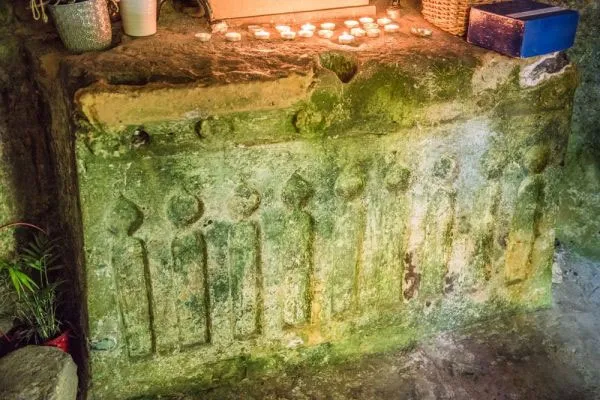
Spring 2009 saw the Shrine Working Group approach English Heritage; Harrogate Borough Council; Historic Churches; and the then owners Ample forth Abbey Trust with a Project Plan and a request for assistance with funding restoration work to the Chapel Knight, window, improvements to the access path and congregation area for which the Group were responsible.
The Group had already received a quote from the conservation company Skillington’s, who were approved by English Heritage.
A grant was only offered by Harrogate Borough Council, but with public donations Skillington’s were able to carry out the work on the knight in Autumn 2009 and the chapel window in Summer 2010.
The Knight Rock Carving
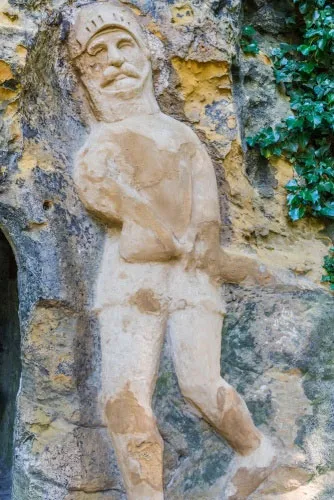
Carved into the rock beside the chapel entrance is the life-sized figure of a knight, one hand on his sword. We do not know precisely when the knight was carved, but it may be contemporary with the chapel foundation (ie. 1408). The head may have been recut in the Victorian period.
When removing the bitumen from around the Knight and the cement from the actual figure (which was causing deterioration as the moisture could not escape except from weaker points), the Knight’s head fell into the conservator’s arms.
It was thought that for some reason the head had been replaced in Victorian times, as there are a few pictures coming to light showing the original “protector” of the Chapel as a bare headed person.
Although the compound used in the restoration of the Knight was mixed to match the colour of the stone, it has never dried fully, leaving darker patches.
In hindsight, had that been the known outcome then the Group would have asked whether just a regular protection coating would have been a better solution to saving the Knight.
Damage to Knight’s Knee 2016
In 2016 it was noted that part of the Knight’s knee was missing;although there has been communication with Skillington’s they have not been able to view the knee and offer an estimate to the cost.
The Group –now Trustees since early 2017 have requested support from English Heritage in finding a Conservation Company who are able to make the necessary repair.
The Path and Frontage - “The Landing” area of path
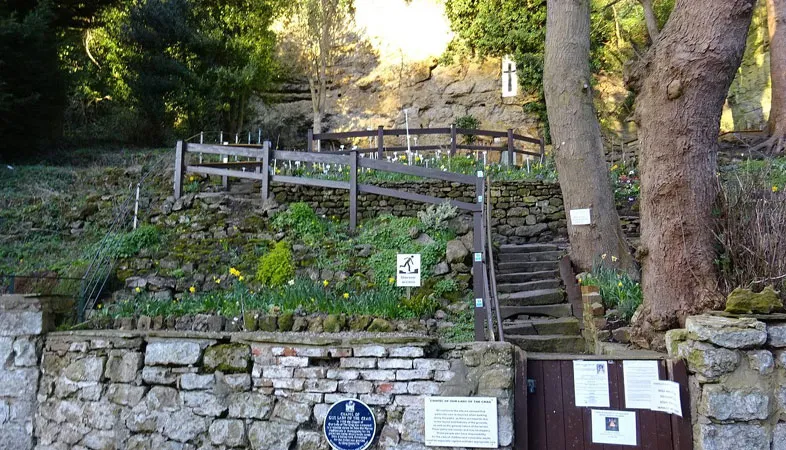
Work was carried out in February 2013 by Stonemason Keith Ledger to the supporting wall along the straight path, between the top of the first steps and the steps on the next corner.
Without this work the Chapel would not have been able to open. Keith felt it was important that the Chapel remain accessible to as many as possible to see the work of John the Mason and offered to complete the work at a fraction of the actual cost.
He created the new wall whilst waiting for a back operation, with his Chiropractor visiting often to watch him at work! Landing Path prior to wall restoration.
Cave and Access
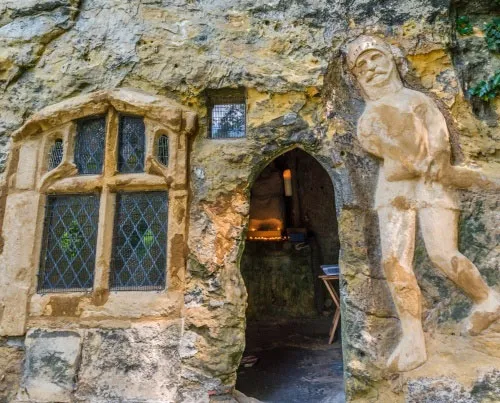
The chapel, dedicated to St Mary, is a Grade I Listed Building that is reached via a narrow path and steps from Abbey Road. The Chapel has a carved altar with a canopied niche, gargoyles, a vaulted ceiling, roof bosses, pillars with floriate capitals, a Celtic head, a piscina and externally a large carving of a medieval knight guards the entrance. The vaulted ceiling is similar to that of Wallace’s Cave at Auchinleck in Ayrshire.
The figure of the knight may be contemporary with the chapel, although Historic England date it to between 1695 and 1739. It was certainly present in 1814 when it was mentioned by William Wordsworth. The head is separate from the body and may have been recarved in the Victorian times.
In 1907 the OS map shows a path running from the chapel to the nearby ‘House in the Rock’. The steps cut into the sandstone are still present but very worn. This map records the site erroneously as ‘St Roberts Chapel’.
Feast Day - 10th August
Annual Feast Day of Virgen de la Peña / Our Lady of the Crag, Bogotà, Colombia (1685) and Memorials of the Saints – 10th August.
Church Visiting Time
- Sundays : 2:00 pm to 4:00 pm
Contact Info
Abbey Road, Knaresborough HG5 8HY,
Harrogate, North Yorkshire, United Kingdom
Phone No.
Tel : +44 1423 861584
Accommodations
How to reach the Chapel
Leeds Bradford (LBA) Airport is the nearby airport to the Chapel.
Knaresborough Railway Station in North Yorkshire, England is the nearby train station to the Chapel.








